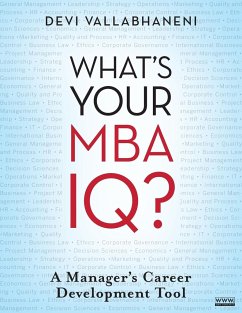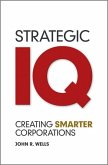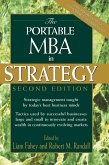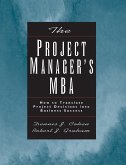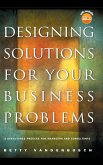- Broschiertes Buch
- Merkliste
- Auf die Merkliste
- Bewerten Bewerten
- Teilen
- Produkt teilen
- Produkterinnerung
- Produkterinnerung
Der ultimative Ratgeber für zukünftige BWL-Studenten, leitende Angestellte und Führungskräfte, der Kernkompetenzen in zehn wichtigen Bereichen der Unternehmensführung vermittelt.
In dem heutigen wirtschaftlichen Umfeld müssen Führungskräfte in jedem Unternehmensbereich, von der Produktion über das Marketing und Personalwesen, die Buchhaltung und Finanzabteilung bis hin zur Unternehmensorganisation und zu internationalen Beziehungen usw. ihr Metier perfekt beherrschen. Vallabhaneni führt die Manager von heute durch zehn zentrale Bereiche, in denen Kompetenz unabdingbar ist. Mit Tests zur…mehr
Andere Kunden interessierten sich auch für
![Strategic IQ Strategic IQ]() John R. WellsStrategic IQ33,99 €
John R. WellsStrategic IQ33,99 €![The Portable MBA in Strategy The Portable MBA in Strategy]() Liam FaheyThe Portable MBA in Strategy63,99 €
Liam FaheyThe Portable MBA in Strategy63,99 €![The Portable MBA in Project Management The Portable MBA in Project Management]() The Portable MBA in Project Management46,99 €
The Portable MBA in Project Management46,99 €![Focus Focus]() Daniel GolemanFocus15,99 €
Daniel GolemanFocus15,99 €![The Project Manager's MBA The Project Manager's MBA]() Dennis J. CohenThe Project Manager's MBA60,99 €
Dennis J. CohenThe Project Manager's MBA60,99 €![The Portable MBA in Entrepreneurship The Portable MBA in Entrepreneurship]() William D. BygraveThe Portable MBA in Entrepreneurship36,99 €
William D. BygraveThe Portable MBA in Entrepreneurship36,99 €![Designing Solutions for Your Business Problems Designing Solutions for Your Business Problems]() Betty VandenboschDesigning Solutions for Your Business Problems86,99 €
Betty VandenboschDesigning Solutions for Your Business Problems86,99 €-
-
-
Der ultimative Ratgeber für zukünftige BWL-Studenten, leitende Angestellte und Führungskräfte, der Kernkompetenzen in zehn wichtigen Bereichen der Unternehmensführung vermittelt.
In dem heutigen wirtschaftlichen Umfeld müssen Führungskräfte in jedem Unternehmensbereich, von der Produktion über das Marketing und Personalwesen, die Buchhaltung und Finanzabteilung bis hin zur Unternehmensorganisation und zu internationalen Beziehungen usw. ihr Metier perfekt beherrschen. Vallabhaneni führt die Manager von heute durch zehn zentrale Bereiche, in denen Kompetenz unabdingbar ist. Mit Tests zur Selbsteinschätzung lässt sich ein Management-Intelligenzquotient (MQ) ermitteln, der sich für die einzelnen Geschäftsbereiche aus den Parametern "organisationsbezogenes Bewusstsein", "Identifikation" und "Entwicklungsfähigkeit" ableitet. Der MQ ist von essenzieller Bedeutung für die Entwicklung des persönlichen beruflichen Erfolgs und die Aufnahme eines Studiums im Bereich Management und der erste Schritt auf dem Weg hin zu einem kompetenten Manager. Mit diesem prägnant geschriebenen und dennoch umfassenden Leitfaden können Manager ihren persönlichen MQ ermitteln, ihre Stärken und Schwächen ausloten und so den Vorsprung vor der Konkurrenz noch deutlicher machen.
Hinweis: Dieser Artikel kann nur an eine deutsche Lieferadresse ausgeliefert werden.
In dem heutigen wirtschaftlichen Umfeld müssen Führungskräfte in jedem Unternehmensbereich, von der Produktion über das Marketing und Personalwesen, die Buchhaltung und Finanzabteilung bis hin zur Unternehmensorganisation und zu internationalen Beziehungen usw. ihr Metier perfekt beherrschen. Vallabhaneni führt die Manager von heute durch zehn zentrale Bereiche, in denen Kompetenz unabdingbar ist. Mit Tests zur Selbsteinschätzung lässt sich ein Management-Intelligenzquotient (MQ) ermitteln, der sich für die einzelnen Geschäftsbereiche aus den Parametern "organisationsbezogenes Bewusstsein", "Identifikation" und "Entwicklungsfähigkeit" ableitet. Der MQ ist von essenzieller Bedeutung für die Entwicklung des persönlichen beruflichen Erfolgs und die Aufnahme eines Studiums im Bereich Management und der erste Schritt auf dem Weg hin zu einem kompetenten Manager. Mit diesem prägnant geschriebenen und dennoch umfassenden Leitfaden können Manager ihren persönlichen MQ ermitteln, ihre Stärken und Schwächen ausloten und so den Vorsprung vor der Konkurrenz noch deutlicher machen.
Hinweis: Dieser Artikel kann nur an eine deutsche Lieferadresse ausgeliefert werden.
Produktdetails
- Produktdetails
- Verlag: Wiley & Sons
- Artikelnr. des Verlages: 14543957000
- 1. Auflage
- Seitenzahl: 384
- Erscheinungstermin: 1. September 2009
- Englisch
- Abmessung: 280mm x 216mm x 21mm
- Gewicht: 576g
- ISBN-13: 9780470439579
- ISBN-10: 0470439572
- Artikelnr.: 26173486
- Herstellerkennzeichnung
- Libri GmbH
- Europaallee 1
- 36244 Bad Hersfeld
- gpsr@libri.de
- Verlag: Wiley & Sons
- Artikelnr. des Verlages: 14543957000
- 1. Auflage
- Seitenzahl: 384
- Erscheinungstermin: 1. September 2009
- Englisch
- Abmessung: 280mm x 216mm x 21mm
- Gewicht: 576g
- ISBN-13: 9780470439579
- ISBN-10: 0470439572
- Artikelnr.: 26173486
- Herstellerkennzeichnung
- Libri GmbH
- Europaallee 1
- 36244 Bad Hersfeld
- gpsr@libri.de
Devi Vallabhaneni, CABM, CBM, CPA, is the President and CEO of the Association of Professionals in Business Management. Prior to founding this nonprofit and higher-education organization, she worked for Gap, Inc., in international business development, as well as in Gap's online business development where she was responsible for devising expansion strategies for Gap, Banana Republic, and Old Navy brands. In addition, she helped start and worked with Arthur Andersen's litigation services practice at their Singapore and Hong Kong offices. She earned her MBA from the Harvard Business School and sincerely believes that sustained career development begins with knowledge development.
Preface xv
Acknowledgments xvii
Introduction xix
Learning Module 1 General Management, Leadership, and Strategy 1
Learning Objective 1.1: Understand the Scope and Nature of Corporate
Strategies 2
Learning Objective 1.2: Understand the Importance of Planning and
Organizing Skills 10
Learning Objective 1.3: Understand the Importance of Directing and Leading
Skills 14
Learning Objective 1.4: Understand the Importance of Controlling and
Measuring Skills 19
Learning Objective 1.5: Understand the Importance of Motivating Skills 21
Learning Objective 1.6: Understand the Importance of Problem-Solving and
Decision-Making Skills 23
Learning Objective 1.7: Understand the Importance of Negotiating Skills 30
Learning Objective 1.8: Understand the Importance of Communication Skills
32
Learning Objective 1.9: Understand the Importance of Conflict Management
Skills 35
Learning Objective 1.10: Understand the Various Issues in Organizational
Behavior, Culture, Change,
Development, Effectiveness, and Decline 38
Learning Objective 1.11: Understand How to Measure and Manage Business
Performance Results 42
Learning Module 2 Operations Management 45
Learning Objective 2.1: Understand the Strategic Importance of Demand
Forecasting 46
Learning Objective 2.2: Understand the Production Strategies and
Manufacturing Performance Measures 47
Learning Objective 2.3: Understand the Production-Related Value Concepts 48
Learning Objective 2.4: Understand the Philosophies of Just-In-Time and
Lean Operations 49
Learning Objective 2.5: Understand the Principles and Techniques of
Inventory Management 52
Learning Objective 2.6: Understand the Principles and Techniques of
Supply-Chain and Logistics Management 56
Learning Objective 2.7: Understand the Various Planning Systems Applicable
to Manufacturing and Distribution Operations 58
Learning Objective 2.8: Understand the Various Short-Term Scheduling
Systems Used in Production 60
Learning Objective 2.9: Understand the Theory of Constraints in Operations
62
Learning Objective 2.10: Understand the Principles of Production Economics
and Application of Decision Tools 63
Learning Objective 2.11: Understand the Principles and Techniques of
Equipment Maintenance and System Reliability 65
Learning Objective 2.12: Understand the Production Process Flows and
Metrics 66
Learning Objective 2.13: Understand the Technology Deployed in
Manufacturing and Service Operations 67
Learning Module 3 Marketing Management 71
Learning Objective 3.1: Understand the Components of Marketing Mix 72
Learning Objective 3.2: Understand the Expectancy-Value Model in Consumer
Markets 72
Learning Objective 3.3: Understand the Brand Elements and Calculate a Brand
Value 72
Learning Objective 3.4: Understand Competitor Analysis 73
Learning Objective 3.5: Understand the Pricing Strategies and Methods 73
Learning Objective 3.6: Understand the Marketing Communications Mix 75
Learning Objective 3.7: Understand the New-Product Development Process 75
Learning Objective 3.8: Compute the Customer Retention Rate 76
Learning Objective 3.9: Compute the Lifetime Value of a Customer 77
Learning Objective 3.10: Compute the Customer Conviction in Terms of Net
Promoter Score 78
Learning Objective 3.11: Compute the Customer Loyalty Score 78
Learning Objective 3.12: Compute the Net Marketing Contribution Amount 78
Learning Objective 3.13: Compute the Marketing Profitability Metrics 80
Learning Objective 3.14: Compute the Market Development Index 80
Learning Objective 3.15: Compute the Market Share Index 80
Learning Objective 3.16: Compute a Product's Lifecycle Cost and Economic
Value to a Customer 81
Learning Objective 3.17: Compute the Relative Performance, Price, and
Customer Value of a Product 81
Learning Objective 3.18: Compute a Marketing Channel Intermediary's
Transaction Value 82
Learning Objective 3.19: Understand the Relationships Among Price, Profit,
and Market Share 83
Learning Objective 3.20: Understand a Marketing Channel's Performance 83
Learning Objective 3.21: Evaluate the Advertising's Effectiveness with
Customer Response Index 83
Learning Objective 3.22: Learn How to Conduct a Marketing Portfolio
Analysis 85
LearningObjective 3.23: Learn How to Develop a Marketing Budget 85
Learning Objective 3.24: Understand the Financial Performance Metrics
Related to Marketing 85
Learning Objective 3.25: Understand the Nature of Marketing of Services 86
Learning Objective 3.26: Understand the Strategies in Product Management 87
Learning Objective 3.27: Understand the Stages in a Product Lifecycle 88
Learning Module 4 Quality and Process Management 91
Learning Objective 4.1: Understand the Basic Quality Concepts 91
Learning Objective 4.2: Understand the Various Definitions of Quality 93
Learning Objective 4.3: Calculate the Cost of Quality 94
Learning Objective 4.4: Calculate the Six-Sigma Metric 94
Learning Objective 4.5: Compute the Return-on-Quality Metric 96
Learning Objective 4.6: Apply Quality Tools 96
Learning Objective 4.7: Apply Statistical Process Control Techniques 98
Learning Objective 4.8: Compute Taguchi's Quality Loss Function 100
Learning Objective 4.9: Understand the Role of Inspection and Quality at
Source 100
Learning Objective 4.10: Understand the Process Management Methods and
Tools 101
Learning Module 5 Human Resources Management 103
Learning Objective 5.1: Understand the Human Resources Planning Process 103
Learning Objective 5.2: Understand the Relationship between Job Analysis
and Job Descriptions 104
Learning Objective 5.3: Understand the Recruitment Methods and Alternatives
105
Learning Objective 5.4: Understand the Employee Selection Process 106
Learning Objective 5.5: Understand the Employee Selection Tests and their
Characteristics 107
Learning Objective 5.6: Understand the Employment Interview Process 108
Learning Objective 5.7: Understand the Pre-Employment Screening Process 108
Learning Objective 5.8: Understand the Employee Training and Development
Process 109
Learning Objective 5.9: Understand the Management Development Process 110
Learning Objective 5.10: Understand the Organization Development Process
111
Learning Objective 5.11: Understand the Career Planning and Development
Process 112
Learning Objective 5.12: Understand the Employee Performance Appraisal
Process 113
Learning Objective 5.13: Understand the Employee Relations Issues 114
Learning Objective 5.14: Compute the Human Capital Metrics 116
Learning Module 6 Accounting 119
Learning Objective 6.1: Understand the Basic Concepts of Financial
Accounting 120
Learning Objective 6.2: Understand the Purpose of the Accounting Cycle 121
Learning Objective 6.3: Understand the Types and Contents of Financial
Statements 122
Learning Objective 6.4: Understand the Intermediate Concepts of Financial
Accounting 128
Learning Objective 6.5: Understand the Advanced Concepts of Financial
Accounting 132
Learning Objective 6.6: Learn How to Analyze Financial Statements 133
Learning Objective 6.7: Understand Various Cost Concepts and Cost Behaviors
140
Learning Objective 6.8: Understand the Principles and Techniques of
Operating Budgets 143
Learning Objective 6.9: Understand the Application of Transfer Pricing 146
Learning Objective 6.10: Understand the Application of Cost-Volume-Profit
Analysis 148
Learning Objective 6.11: Understand the Meaning and Application of Relevant
Costs 150
Learning Objective 6.12: Understand Various Costing Systems for Products
and Services 151
Learning Objective 6.13: Understand the Meaning and Application of
Responsibility Accounting 152
Learning Module 7 Finance 153
Learning Objective 7.1: Understand the Need for Financial Plans and
Controls 154
Learning Objective 7.2: Understand the Principles and Techniques of Cash
Management 157
Learning Objective 7.3: Understand the Techniques of Managing Current
Assets 160
Learning Objective 7.4: Understand the Various Types of Debt and Equity in
a Capital Structure 163
Learning Objective 7.5: Understand the Techniques for Evaluating the Cost
of Capital 169
Learning Objective 7.6: Understand the Principles and Techniques of Capital
Budgeting 171
Learning Objective 7.7: Understand the Various Types and Risks of Financial
Instruments 179
Learning Objective 7.8: Understand the Various Types of Valuation Models
182
Learning Objective 7.9: Understand the Nature of Business Mergers and
Acquisitions 185
Learning Objective 7.10: Understand the Implications of Dividend Policies,
Stock Splits, Stock Dividends, and Stock Repurchases 187
Learning Module 8 Information Technology 191
Learning Objective 8.1: Understand How to Plan and Manage the Information
Technology Function 192
Learning Objective 8.2: Understand How Business Application Systems are
Developed and Maintained 196
Learning Objective 8.3: Understand How Business Application Systems are
Operated and Improved 198
Learning Objective 8.4: Understand the Need for Contingency Plans to Ensure
the Continuity of Business Operations 201
Learning Objective 8.5: Understand How Information Technology Operations
Are Managed 207
Learning Objective 8.6: Understand the Technology Behind Computer Network
Management 211
Learning Objective 8.7: Understand how to Manage the Information Technology
Security Function 217
Learning Objective 8.8: Understand How Databases are Designed and Managed
223
Learning Objective 8.9: Understand How Electronic Commerce is Facilitated
and Managed 228
Learning Module 9 Corporate Control, Law, Ethics, and Governance 235
Learning Objective 9.1: Understand the Nature and Types of Corporate
Control Systems 236
Learning Objective 9.2: Understand the Nature and Types of Corporate Risk
241
Learning Objective 9.3: Understand the Scope and Nature of Business Law,
Policy, and Ethics, Including Social Responsibility 247
Learning Objective 9.4: Understand the Various Issues in Corporate
Governance 256
Learning Objective 9.5: Understand the Nature and Types of Corporate Audits
260
Learning Objective 9.6: Understand the Nature and Types of Corporate Fraud
263
Learning Objective 9.7: Understand the Issues in Corporate Law Regarding
Agency Problems and Costs 266
Learning Module 10 International Business 269
Learning Objective 10.1: Understand How to Develop and Manage International
Business Strategies 269
Learning Objective 10.2: Understand the Various Issues in International
Trade and Investment 271
Learning Objective 10.3: Understand the Nature of International Production
Economics 275
Learning Objective 10.4: Understand the Nature of International Trade Laws
276
Learning Objective 10.5: Understand the Various Issues in International
Financial Systems 280
Learning Objective 10.6: Understand How to Staff and Manage International
Operations 281
Learning Objective 10.7: Understand the Various Issues in Conducting
International Business in Cross Cultures 281
Learning Module 11 Project Management 287
Learning Objective 11.1: Define Project Management and Identify Success
Criteria for Projects 287
Learning Objective 11.2: Understand the Various Types of Risks in Project
Management 289
Learning Objective 11.3: Understand the Various Types of Project Structures
and Organizations 291
Learning Objective 11.4: Understand the Project Management Process,
Including its Lifecycles 294
Learning Objective 11.5: Understand the Various Methods in Project
Planning, Estimating, Controlling, and Reporting 296
Learning Objective 11.6: Understand the Various Methods in Project
Scheduling 303
Learning Objective 11.7: Understand the Project Management Metrics,
Problems, and Governance Mechanisms, Including Project Audits 306
Learning Module 12 Decision Sciences and Managerial Economics 311
Learning Objective 12.1: Learn How to Apply Quantitative Methods to
Business 311
Learning Objective 12.2: Understand the Basic Principles and Concepts in
Economics 321
Learning Objective 12.3: Understand the Basic Principles and Applications
of Microeconomics 322
Learning Objective 12.4: Understand the Basic Principles and Applications
of Macroeconomics 325
Learning Objective 12.5: Understand the Basic Principles and Applications
of Key Economic Indicators 332
Learning Objective 12.6: Understand the Nature of Economic Business Cycles
and Industry Growth Levels 333
References 337
Index 339
Acknowledgments xvii
Introduction xix
Learning Module 1 General Management, Leadership, and Strategy 1
Learning Objective 1.1: Understand the Scope and Nature of Corporate
Strategies 2
Learning Objective 1.2: Understand the Importance of Planning and
Organizing Skills 10
Learning Objective 1.3: Understand the Importance of Directing and Leading
Skills 14
Learning Objective 1.4: Understand the Importance of Controlling and
Measuring Skills 19
Learning Objective 1.5: Understand the Importance of Motivating Skills 21
Learning Objective 1.6: Understand the Importance of Problem-Solving and
Decision-Making Skills 23
Learning Objective 1.7: Understand the Importance of Negotiating Skills 30
Learning Objective 1.8: Understand the Importance of Communication Skills
32
Learning Objective 1.9: Understand the Importance of Conflict Management
Skills 35
Learning Objective 1.10: Understand the Various Issues in Organizational
Behavior, Culture, Change,
Development, Effectiveness, and Decline 38
Learning Objective 1.11: Understand How to Measure and Manage Business
Performance Results 42
Learning Module 2 Operations Management 45
Learning Objective 2.1: Understand the Strategic Importance of Demand
Forecasting 46
Learning Objective 2.2: Understand the Production Strategies and
Manufacturing Performance Measures 47
Learning Objective 2.3: Understand the Production-Related Value Concepts 48
Learning Objective 2.4: Understand the Philosophies of Just-In-Time and
Lean Operations 49
Learning Objective 2.5: Understand the Principles and Techniques of
Inventory Management 52
Learning Objective 2.6: Understand the Principles and Techniques of
Supply-Chain and Logistics Management 56
Learning Objective 2.7: Understand the Various Planning Systems Applicable
to Manufacturing and Distribution Operations 58
Learning Objective 2.8: Understand the Various Short-Term Scheduling
Systems Used in Production 60
Learning Objective 2.9: Understand the Theory of Constraints in Operations
62
Learning Objective 2.10: Understand the Principles of Production Economics
and Application of Decision Tools 63
Learning Objective 2.11: Understand the Principles and Techniques of
Equipment Maintenance and System Reliability 65
Learning Objective 2.12: Understand the Production Process Flows and
Metrics 66
Learning Objective 2.13: Understand the Technology Deployed in
Manufacturing and Service Operations 67
Learning Module 3 Marketing Management 71
Learning Objective 3.1: Understand the Components of Marketing Mix 72
Learning Objective 3.2: Understand the Expectancy-Value Model in Consumer
Markets 72
Learning Objective 3.3: Understand the Brand Elements and Calculate a Brand
Value 72
Learning Objective 3.4: Understand Competitor Analysis 73
Learning Objective 3.5: Understand the Pricing Strategies and Methods 73
Learning Objective 3.6: Understand the Marketing Communications Mix 75
Learning Objective 3.7: Understand the New-Product Development Process 75
Learning Objective 3.8: Compute the Customer Retention Rate 76
Learning Objective 3.9: Compute the Lifetime Value of a Customer 77
Learning Objective 3.10: Compute the Customer Conviction in Terms of Net
Promoter Score 78
Learning Objective 3.11: Compute the Customer Loyalty Score 78
Learning Objective 3.12: Compute the Net Marketing Contribution Amount 78
Learning Objective 3.13: Compute the Marketing Profitability Metrics 80
Learning Objective 3.14: Compute the Market Development Index 80
Learning Objective 3.15: Compute the Market Share Index 80
Learning Objective 3.16: Compute a Product's Lifecycle Cost and Economic
Value to a Customer 81
Learning Objective 3.17: Compute the Relative Performance, Price, and
Customer Value of a Product 81
Learning Objective 3.18: Compute a Marketing Channel Intermediary's
Transaction Value 82
Learning Objective 3.19: Understand the Relationships Among Price, Profit,
and Market Share 83
Learning Objective 3.20: Understand a Marketing Channel's Performance 83
Learning Objective 3.21: Evaluate the Advertising's Effectiveness with
Customer Response Index 83
Learning Objective 3.22: Learn How to Conduct a Marketing Portfolio
Analysis 85
LearningObjective 3.23: Learn How to Develop a Marketing Budget 85
Learning Objective 3.24: Understand the Financial Performance Metrics
Related to Marketing 85
Learning Objective 3.25: Understand the Nature of Marketing of Services 86
Learning Objective 3.26: Understand the Strategies in Product Management 87
Learning Objective 3.27: Understand the Stages in a Product Lifecycle 88
Learning Module 4 Quality and Process Management 91
Learning Objective 4.1: Understand the Basic Quality Concepts 91
Learning Objective 4.2: Understand the Various Definitions of Quality 93
Learning Objective 4.3: Calculate the Cost of Quality 94
Learning Objective 4.4: Calculate the Six-Sigma Metric 94
Learning Objective 4.5: Compute the Return-on-Quality Metric 96
Learning Objective 4.6: Apply Quality Tools 96
Learning Objective 4.7: Apply Statistical Process Control Techniques 98
Learning Objective 4.8: Compute Taguchi's Quality Loss Function 100
Learning Objective 4.9: Understand the Role of Inspection and Quality at
Source 100
Learning Objective 4.10: Understand the Process Management Methods and
Tools 101
Learning Module 5 Human Resources Management 103
Learning Objective 5.1: Understand the Human Resources Planning Process 103
Learning Objective 5.2: Understand the Relationship between Job Analysis
and Job Descriptions 104
Learning Objective 5.3: Understand the Recruitment Methods and Alternatives
105
Learning Objective 5.4: Understand the Employee Selection Process 106
Learning Objective 5.5: Understand the Employee Selection Tests and their
Characteristics 107
Learning Objective 5.6: Understand the Employment Interview Process 108
Learning Objective 5.7: Understand the Pre-Employment Screening Process 108
Learning Objective 5.8: Understand the Employee Training and Development
Process 109
Learning Objective 5.9: Understand the Management Development Process 110
Learning Objective 5.10: Understand the Organization Development Process
111
Learning Objective 5.11: Understand the Career Planning and Development
Process 112
Learning Objective 5.12: Understand the Employee Performance Appraisal
Process 113
Learning Objective 5.13: Understand the Employee Relations Issues 114
Learning Objective 5.14: Compute the Human Capital Metrics 116
Learning Module 6 Accounting 119
Learning Objective 6.1: Understand the Basic Concepts of Financial
Accounting 120
Learning Objective 6.2: Understand the Purpose of the Accounting Cycle 121
Learning Objective 6.3: Understand the Types and Contents of Financial
Statements 122
Learning Objective 6.4: Understand the Intermediate Concepts of Financial
Accounting 128
Learning Objective 6.5: Understand the Advanced Concepts of Financial
Accounting 132
Learning Objective 6.6: Learn How to Analyze Financial Statements 133
Learning Objective 6.7: Understand Various Cost Concepts and Cost Behaviors
140
Learning Objective 6.8: Understand the Principles and Techniques of
Operating Budgets 143
Learning Objective 6.9: Understand the Application of Transfer Pricing 146
Learning Objective 6.10: Understand the Application of Cost-Volume-Profit
Analysis 148
Learning Objective 6.11: Understand the Meaning and Application of Relevant
Costs 150
Learning Objective 6.12: Understand Various Costing Systems for Products
and Services 151
Learning Objective 6.13: Understand the Meaning and Application of
Responsibility Accounting 152
Learning Module 7 Finance 153
Learning Objective 7.1: Understand the Need for Financial Plans and
Controls 154
Learning Objective 7.2: Understand the Principles and Techniques of Cash
Management 157
Learning Objective 7.3: Understand the Techniques of Managing Current
Assets 160
Learning Objective 7.4: Understand the Various Types of Debt and Equity in
a Capital Structure 163
Learning Objective 7.5: Understand the Techniques for Evaluating the Cost
of Capital 169
Learning Objective 7.6: Understand the Principles and Techniques of Capital
Budgeting 171
Learning Objective 7.7: Understand the Various Types and Risks of Financial
Instruments 179
Learning Objective 7.8: Understand the Various Types of Valuation Models
182
Learning Objective 7.9: Understand the Nature of Business Mergers and
Acquisitions 185
Learning Objective 7.10: Understand the Implications of Dividend Policies,
Stock Splits, Stock Dividends, and Stock Repurchases 187
Learning Module 8 Information Technology 191
Learning Objective 8.1: Understand How to Plan and Manage the Information
Technology Function 192
Learning Objective 8.2: Understand How Business Application Systems are
Developed and Maintained 196
Learning Objective 8.3: Understand How Business Application Systems are
Operated and Improved 198
Learning Objective 8.4: Understand the Need for Contingency Plans to Ensure
the Continuity of Business Operations 201
Learning Objective 8.5: Understand How Information Technology Operations
Are Managed 207
Learning Objective 8.6: Understand the Technology Behind Computer Network
Management 211
Learning Objective 8.7: Understand how to Manage the Information Technology
Security Function 217
Learning Objective 8.8: Understand How Databases are Designed and Managed
223
Learning Objective 8.9: Understand How Electronic Commerce is Facilitated
and Managed 228
Learning Module 9 Corporate Control, Law, Ethics, and Governance 235
Learning Objective 9.1: Understand the Nature and Types of Corporate
Control Systems 236
Learning Objective 9.2: Understand the Nature and Types of Corporate Risk
241
Learning Objective 9.3: Understand the Scope and Nature of Business Law,
Policy, and Ethics, Including Social Responsibility 247
Learning Objective 9.4: Understand the Various Issues in Corporate
Governance 256
Learning Objective 9.5: Understand the Nature and Types of Corporate Audits
260
Learning Objective 9.6: Understand the Nature and Types of Corporate Fraud
263
Learning Objective 9.7: Understand the Issues in Corporate Law Regarding
Agency Problems and Costs 266
Learning Module 10 International Business 269
Learning Objective 10.1: Understand How to Develop and Manage International
Business Strategies 269
Learning Objective 10.2: Understand the Various Issues in International
Trade and Investment 271
Learning Objective 10.3: Understand the Nature of International Production
Economics 275
Learning Objective 10.4: Understand the Nature of International Trade Laws
276
Learning Objective 10.5: Understand the Various Issues in International
Financial Systems 280
Learning Objective 10.6: Understand How to Staff and Manage International
Operations 281
Learning Objective 10.7: Understand the Various Issues in Conducting
International Business in Cross Cultures 281
Learning Module 11 Project Management 287
Learning Objective 11.1: Define Project Management and Identify Success
Criteria for Projects 287
Learning Objective 11.2: Understand the Various Types of Risks in Project
Management 289
Learning Objective 11.3: Understand the Various Types of Project Structures
and Organizations 291
Learning Objective 11.4: Understand the Project Management Process,
Including its Lifecycles 294
Learning Objective 11.5: Understand the Various Methods in Project
Planning, Estimating, Controlling, and Reporting 296
Learning Objective 11.6: Understand the Various Methods in Project
Scheduling 303
Learning Objective 11.7: Understand the Project Management Metrics,
Problems, and Governance Mechanisms, Including Project Audits 306
Learning Module 12 Decision Sciences and Managerial Economics 311
Learning Objective 12.1: Learn How to Apply Quantitative Methods to
Business 311
Learning Objective 12.2: Understand the Basic Principles and Concepts in
Economics 321
Learning Objective 12.3: Understand the Basic Principles and Applications
of Microeconomics 322
Learning Objective 12.4: Understand the Basic Principles and Applications
of Macroeconomics 325
Learning Objective 12.5: Understand the Basic Principles and Applications
of Key Economic Indicators 332
Learning Objective 12.6: Understand the Nature of Economic Business Cycles
and Industry Growth Levels 333
References 337
Index 339
Preface xv
Acknowledgments xvii
Introduction xix
Learning Module 1 General Management, Leadership, and Strategy 1
Learning Objective 1.1: Understand the Scope and Nature of Corporate
Strategies 2
Learning Objective 1.2: Understand the Importance of Planning and
Organizing Skills 10
Learning Objective 1.3: Understand the Importance of Directing and Leading
Skills 14
Learning Objective 1.4: Understand the Importance of Controlling and
Measuring Skills 19
Learning Objective 1.5: Understand the Importance of Motivating Skills 21
Learning Objective 1.6: Understand the Importance of Problem-Solving and
Decision-Making Skills 23
Learning Objective 1.7: Understand the Importance of Negotiating Skills 30
Learning Objective 1.8: Understand the Importance of Communication Skills
32
Learning Objective 1.9: Understand the Importance of Conflict Management
Skills 35
Learning Objective 1.10: Understand the Various Issues in Organizational
Behavior, Culture, Change,
Development, Effectiveness, and Decline 38
Learning Objective 1.11: Understand How to Measure and Manage Business
Performance Results 42
Learning Module 2 Operations Management 45
Learning Objective 2.1: Understand the Strategic Importance of Demand
Forecasting 46
Learning Objective 2.2: Understand the Production Strategies and
Manufacturing Performance Measures 47
Learning Objective 2.3: Understand the Production-Related Value Concepts 48
Learning Objective 2.4: Understand the Philosophies of Just-In-Time and
Lean Operations 49
Learning Objective 2.5: Understand the Principles and Techniques of
Inventory Management 52
Learning Objective 2.6: Understand the Principles and Techniques of
Supply-Chain and Logistics Management 56
Learning Objective 2.7: Understand the Various Planning Systems Applicable
to Manufacturing and Distribution Operations 58
Learning Objective 2.8: Understand the Various Short-Term Scheduling
Systems Used in Production 60
Learning Objective 2.9: Understand the Theory of Constraints in Operations
62
Learning Objective 2.10: Understand the Principles of Production Economics
and Application of Decision Tools 63
Learning Objective 2.11: Understand the Principles and Techniques of
Equipment Maintenance and System Reliability 65
Learning Objective 2.12: Understand the Production Process Flows and
Metrics 66
Learning Objective 2.13: Understand the Technology Deployed in
Manufacturing and Service Operations 67
Learning Module 3 Marketing Management 71
Learning Objective 3.1: Understand the Components of Marketing Mix 72
Learning Objective 3.2: Understand the Expectancy-Value Model in Consumer
Markets 72
Learning Objective 3.3: Understand the Brand Elements and Calculate a Brand
Value 72
Learning Objective 3.4: Understand Competitor Analysis 73
Learning Objective 3.5: Understand the Pricing Strategies and Methods 73
Learning Objective 3.6: Understand the Marketing Communications Mix 75
Learning Objective 3.7: Understand the New-Product Development Process 75
Learning Objective 3.8: Compute the Customer Retention Rate 76
Learning Objective 3.9: Compute the Lifetime Value of a Customer 77
Learning Objective 3.10: Compute the Customer Conviction in Terms of Net
Promoter Score 78
Learning Objective 3.11: Compute the Customer Loyalty Score 78
Learning Objective 3.12: Compute the Net Marketing Contribution Amount 78
Learning Objective 3.13: Compute the Marketing Profitability Metrics 80
Learning Objective 3.14: Compute the Market Development Index 80
Learning Objective 3.15: Compute the Market Share Index 80
Learning Objective 3.16: Compute a Product's Lifecycle Cost and Economic
Value to a Customer 81
Learning Objective 3.17: Compute the Relative Performance, Price, and
Customer Value of a Product 81
Learning Objective 3.18: Compute a Marketing Channel Intermediary's
Transaction Value 82
Learning Objective 3.19: Understand the Relationships Among Price, Profit,
and Market Share 83
Learning Objective 3.20: Understand a Marketing Channel's Performance 83
Learning Objective 3.21: Evaluate the Advertising's Effectiveness with
Customer Response Index 83
Learning Objective 3.22: Learn How to Conduct a Marketing Portfolio
Analysis 85
LearningObjective 3.23: Learn How to Develop a Marketing Budget 85
Learning Objective 3.24: Understand the Financial Performance Metrics
Related to Marketing 85
Learning Objective 3.25: Understand the Nature of Marketing of Services 86
Learning Objective 3.26: Understand the Strategies in Product Management 87
Learning Objective 3.27: Understand the Stages in a Product Lifecycle 88
Learning Module 4 Quality and Process Management 91
Learning Objective 4.1: Understand the Basic Quality Concepts 91
Learning Objective 4.2: Understand the Various Definitions of Quality 93
Learning Objective 4.3: Calculate the Cost of Quality 94
Learning Objective 4.4: Calculate the Six-Sigma Metric 94
Learning Objective 4.5: Compute the Return-on-Quality Metric 96
Learning Objective 4.6: Apply Quality Tools 96
Learning Objective 4.7: Apply Statistical Process Control Techniques 98
Learning Objective 4.8: Compute Taguchi's Quality Loss Function 100
Learning Objective 4.9: Understand the Role of Inspection and Quality at
Source 100
Learning Objective 4.10: Understand the Process Management Methods and
Tools 101
Learning Module 5 Human Resources Management 103
Learning Objective 5.1: Understand the Human Resources Planning Process 103
Learning Objective 5.2: Understand the Relationship between Job Analysis
and Job Descriptions 104
Learning Objective 5.3: Understand the Recruitment Methods and Alternatives
105
Learning Objective 5.4: Understand the Employee Selection Process 106
Learning Objective 5.5: Understand the Employee Selection Tests and their
Characteristics 107
Learning Objective 5.6: Understand the Employment Interview Process 108
Learning Objective 5.7: Understand the Pre-Employment Screening Process 108
Learning Objective 5.8: Understand the Employee Training and Development
Process 109
Learning Objective 5.9: Understand the Management Development Process 110
Learning Objective 5.10: Understand the Organization Development Process
111
Learning Objective 5.11: Understand the Career Planning and Development
Process 112
Learning Objective 5.12: Understand the Employee Performance Appraisal
Process 113
Learning Objective 5.13: Understand the Employee Relations Issues 114
Learning Objective 5.14: Compute the Human Capital Metrics 116
Learning Module 6 Accounting 119
Learning Objective 6.1: Understand the Basic Concepts of Financial
Accounting 120
Learning Objective 6.2: Understand the Purpose of the Accounting Cycle 121
Learning Objective 6.3: Understand the Types and Contents of Financial
Statements 122
Learning Objective 6.4: Understand the Intermediate Concepts of Financial
Accounting 128
Learning Objective 6.5: Understand the Advanced Concepts of Financial
Accounting 132
Learning Objective 6.6: Learn How to Analyze Financial Statements 133
Learning Objective 6.7: Understand Various Cost Concepts and Cost Behaviors
140
Learning Objective 6.8: Understand the Principles and Techniques of
Operating Budgets 143
Learning Objective 6.9: Understand the Application of Transfer Pricing 146
Learning Objective 6.10: Understand the Application of Cost-Volume-Profit
Analysis 148
Learning Objective 6.11: Understand the Meaning and Application of Relevant
Costs 150
Learning Objective 6.12: Understand Various Costing Systems for Products
and Services 151
Learning Objective 6.13: Understand the Meaning and Application of
Responsibility Accounting 152
Learning Module 7 Finance 153
Learning Objective 7.1: Understand the Need for Financial Plans and
Controls 154
Learning Objective 7.2: Understand the Principles and Techniques of Cash
Management 157
Learning Objective 7.3: Understand the Techniques of Managing Current
Assets 160
Learning Objective 7.4: Understand the Various Types of Debt and Equity in
a Capital Structure 163
Learning Objective 7.5: Understand the Techniques for Evaluating the Cost
of Capital 169
Learning Objective 7.6: Understand the Principles and Techniques of Capital
Budgeting 171
Learning Objective 7.7: Understand the Various Types and Risks of Financial
Instruments 179
Learning Objective 7.8: Understand the Various Types of Valuation Models
182
Learning Objective 7.9: Understand the Nature of Business Mergers and
Acquisitions 185
Learning Objective 7.10: Understand the Implications of Dividend Policies,
Stock Splits, Stock Dividends, and Stock Repurchases 187
Learning Module 8 Information Technology 191
Learning Objective 8.1: Understand How to Plan and Manage the Information
Technology Function 192
Learning Objective 8.2: Understand How Business Application Systems are
Developed and Maintained 196
Learning Objective 8.3: Understand How Business Application Systems are
Operated and Improved 198
Learning Objective 8.4: Understand the Need for Contingency Plans to Ensure
the Continuity of Business Operations 201
Learning Objective 8.5: Understand How Information Technology Operations
Are Managed 207
Learning Objective 8.6: Understand the Technology Behind Computer Network
Management 211
Learning Objective 8.7: Understand how to Manage the Information Technology
Security Function 217
Learning Objective 8.8: Understand How Databases are Designed and Managed
223
Learning Objective 8.9: Understand How Electronic Commerce is Facilitated
and Managed 228
Learning Module 9 Corporate Control, Law, Ethics, and Governance 235
Learning Objective 9.1: Understand the Nature and Types of Corporate
Control Systems 236
Learning Objective 9.2: Understand the Nature and Types of Corporate Risk
241
Learning Objective 9.3: Understand the Scope and Nature of Business Law,
Policy, and Ethics, Including Social Responsibility 247
Learning Objective 9.4: Understand the Various Issues in Corporate
Governance 256
Learning Objective 9.5: Understand the Nature and Types of Corporate Audits
260
Learning Objective 9.6: Understand the Nature and Types of Corporate Fraud
263
Learning Objective 9.7: Understand the Issues in Corporate Law Regarding
Agency Problems and Costs 266
Learning Module 10 International Business 269
Learning Objective 10.1: Understand How to Develop and Manage International
Business Strategies 269
Learning Objective 10.2: Understand the Various Issues in International
Trade and Investment 271
Learning Objective 10.3: Understand the Nature of International Production
Economics 275
Learning Objective 10.4: Understand the Nature of International Trade Laws
276
Learning Objective 10.5: Understand the Various Issues in International
Financial Systems 280
Learning Objective 10.6: Understand How to Staff and Manage International
Operations 281
Learning Objective 10.7: Understand the Various Issues in Conducting
International Business in Cross Cultures 281
Learning Module 11 Project Management 287
Learning Objective 11.1: Define Project Management and Identify Success
Criteria for Projects 287
Learning Objective 11.2: Understand the Various Types of Risks in Project
Management 289
Learning Objective 11.3: Understand the Various Types of Project Structures
and Organizations 291
Learning Objective 11.4: Understand the Project Management Process,
Including its Lifecycles 294
Learning Objective 11.5: Understand the Various Methods in Project
Planning, Estimating, Controlling, and Reporting 296
Learning Objective 11.6: Understand the Various Methods in Project
Scheduling 303
Learning Objective 11.7: Understand the Project Management Metrics,
Problems, and Governance Mechanisms, Including Project Audits 306
Learning Module 12 Decision Sciences and Managerial Economics 311
Learning Objective 12.1: Learn How to Apply Quantitative Methods to
Business 311
Learning Objective 12.2: Understand the Basic Principles and Concepts in
Economics 321
Learning Objective 12.3: Understand the Basic Principles and Applications
of Microeconomics 322
Learning Objective 12.4: Understand the Basic Principles and Applications
of Macroeconomics 325
Learning Objective 12.5: Understand the Basic Principles and Applications
of Key Economic Indicators 332
Learning Objective 12.6: Understand the Nature of Economic Business Cycles
and Industry Growth Levels 333
References 337
Index 339
Acknowledgments xvii
Introduction xix
Learning Module 1 General Management, Leadership, and Strategy 1
Learning Objective 1.1: Understand the Scope and Nature of Corporate
Strategies 2
Learning Objective 1.2: Understand the Importance of Planning and
Organizing Skills 10
Learning Objective 1.3: Understand the Importance of Directing and Leading
Skills 14
Learning Objective 1.4: Understand the Importance of Controlling and
Measuring Skills 19
Learning Objective 1.5: Understand the Importance of Motivating Skills 21
Learning Objective 1.6: Understand the Importance of Problem-Solving and
Decision-Making Skills 23
Learning Objective 1.7: Understand the Importance of Negotiating Skills 30
Learning Objective 1.8: Understand the Importance of Communication Skills
32
Learning Objective 1.9: Understand the Importance of Conflict Management
Skills 35
Learning Objective 1.10: Understand the Various Issues in Organizational
Behavior, Culture, Change,
Development, Effectiveness, and Decline 38
Learning Objective 1.11: Understand How to Measure and Manage Business
Performance Results 42
Learning Module 2 Operations Management 45
Learning Objective 2.1: Understand the Strategic Importance of Demand
Forecasting 46
Learning Objective 2.2: Understand the Production Strategies and
Manufacturing Performance Measures 47
Learning Objective 2.3: Understand the Production-Related Value Concepts 48
Learning Objective 2.4: Understand the Philosophies of Just-In-Time and
Lean Operations 49
Learning Objective 2.5: Understand the Principles and Techniques of
Inventory Management 52
Learning Objective 2.6: Understand the Principles and Techniques of
Supply-Chain and Logistics Management 56
Learning Objective 2.7: Understand the Various Planning Systems Applicable
to Manufacturing and Distribution Operations 58
Learning Objective 2.8: Understand the Various Short-Term Scheduling
Systems Used in Production 60
Learning Objective 2.9: Understand the Theory of Constraints in Operations
62
Learning Objective 2.10: Understand the Principles of Production Economics
and Application of Decision Tools 63
Learning Objective 2.11: Understand the Principles and Techniques of
Equipment Maintenance and System Reliability 65
Learning Objective 2.12: Understand the Production Process Flows and
Metrics 66
Learning Objective 2.13: Understand the Technology Deployed in
Manufacturing and Service Operations 67
Learning Module 3 Marketing Management 71
Learning Objective 3.1: Understand the Components of Marketing Mix 72
Learning Objective 3.2: Understand the Expectancy-Value Model in Consumer
Markets 72
Learning Objective 3.3: Understand the Brand Elements and Calculate a Brand
Value 72
Learning Objective 3.4: Understand Competitor Analysis 73
Learning Objective 3.5: Understand the Pricing Strategies and Methods 73
Learning Objective 3.6: Understand the Marketing Communications Mix 75
Learning Objective 3.7: Understand the New-Product Development Process 75
Learning Objective 3.8: Compute the Customer Retention Rate 76
Learning Objective 3.9: Compute the Lifetime Value of a Customer 77
Learning Objective 3.10: Compute the Customer Conviction in Terms of Net
Promoter Score 78
Learning Objective 3.11: Compute the Customer Loyalty Score 78
Learning Objective 3.12: Compute the Net Marketing Contribution Amount 78
Learning Objective 3.13: Compute the Marketing Profitability Metrics 80
Learning Objective 3.14: Compute the Market Development Index 80
Learning Objective 3.15: Compute the Market Share Index 80
Learning Objective 3.16: Compute a Product's Lifecycle Cost and Economic
Value to a Customer 81
Learning Objective 3.17: Compute the Relative Performance, Price, and
Customer Value of a Product 81
Learning Objective 3.18: Compute a Marketing Channel Intermediary's
Transaction Value 82
Learning Objective 3.19: Understand the Relationships Among Price, Profit,
and Market Share 83
Learning Objective 3.20: Understand a Marketing Channel's Performance 83
Learning Objective 3.21: Evaluate the Advertising's Effectiveness with
Customer Response Index 83
Learning Objective 3.22: Learn How to Conduct a Marketing Portfolio
Analysis 85
LearningObjective 3.23: Learn How to Develop a Marketing Budget 85
Learning Objective 3.24: Understand the Financial Performance Metrics
Related to Marketing 85
Learning Objective 3.25: Understand the Nature of Marketing of Services 86
Learning Objective 3.26: Understand the Strategies in Product Management 87
Learning Objective 3.27: Understand the Stages in a Product Lifecycle 88
Learning Module 4 Quality and Process Management 91
Learning Objective 4.1: Understand the Basic Quality Concepts 91
Learning Objective 4.2: Understand the Various Definitions of Quality 93
Learning Objective 4.3: Calculate the Cost of Quality 94
Learning Objective 4.4: Calculate the Six-Sigma Metric 94
Learning Objective 4.5: Compute the Return-on-Quality Metric 96
Learning Objective 4.6: Apply Quality Tools 96
Learning Objective 4.7: Apply Statistical Process Control Techniques 98
Learning Objective 4.8: Compute Taguchi's Quality Loss Function 100
Learning Objective 4.9: Understand the Role of Inspection and Quality at
Source 100
Learning Objective 4.10: Understand the Process Management Methods and
Tools 101
Learning Module 5 Human Resources Management 103
Learning Objective 5.1: Understand the Human Resources Planning Process 103
Learning Objective 5.2: Understand the Relationship between Job Analysis
and Job Descriptions 104
Learning Objective 5.3: Understand the Recruitment Methods and Alternatives
105
Learning Objective 5.4: Understand the Employee Selection Process 106
Learning Objective 5.5: Understand the Employee Selection Tests and their
Characteristics 107
Learning Objective 5.6: Understand the Employment Interview Process 108
Learning Objective 5.7: Understand the Pre-Employment Screening Process 108
Learning Objective 5.8: Understand the Employee Training and Development
Process 109
Learning Objective 5.9: Understand the Management Development Process 110
Learning Objective 5.10: Understand the Organization Development Process
111
Learning Objective 5.11: Understand the Career Planning and Development
Process 112
Learning Objective 5.12: Understand the Employee Performance Appraisal
Process 113
Learning Objective 5.13: Understand the Employee Relations Issues 114
Learning Objective 5.14: Compute the Human Capital Metrics 116
Learning Module 6 Accounting 119
Learning Objective 6.1: Understand the Basic Concepts of Financial
Accounting 120
Learning Objective 6.2: Understand the Purpose of the Accounting Cycle 121
Learning Objective 6.3: Understand the Types and Contents of Financial
Statements 122
Learning Objective 6.4: Understand the Intermediate Concepts of Financial
Accounting 128
Learning Objective 6.5: Understand the Advanced Concepts of Financial
Accounting 132
Learning Objective 6.6: Learn How to Analyze Financial Statements 133
Learning Objective 6.7: Understand Various Cost Concepts and Cost Behaviors
140
Learning Objective 6.8: Understand the Principles and Techniques of
Operating Budgets 143
Learning Objective 6.9: Understand the Application of Transfer Pricing 146
Learning Objective 6.10: Understand the Application of Cost-Volume-Profit
Analysis 148
Learning Objective 6.11: Understand the Meaning and Application of Relevant
Costs 150
Learning Objective 6.12: Understand Various Costing Systems for Products
and Services 151
Learning Objective 6.13: Understand the Meaning and Application of
Responsibility Accounting 152
Learning Module 7 Finance 153
Learning Objective 7.1: Understand the Need for Financial Plans and
Controls 154
Learning Objective 7.2: Understand the Principles and Techniques of Cash
Management 157
Learning Objective 7.3: Understand the Techniques of Managing Current
Assets 160
Learning Objective 7.4: Understand the Various Types of Debt and Equity in
a Capital Structure 163
Learning Objective 7.5: Understand the Techniques for Evaluating the Cost
of Capital 169
Learning Objective 7.6: Understand the Principles and Techniques of Capital
Budgeting 171
Learning Objective 7.7: Understand the Various Types and Risks of Financial
Instruments 179
Learning Objective 7.8: Understand the Various Types of Valuation Models
182
Learning Objective 7.9: Understand the Nature of Business Mergers and
Acquisitions 185
Learning Objective 7.10: Understand the Implications of Dividend Policies,
Stock Splits, Stock Dividends, and Stock Repurchases 187
Learning Module 8 Information Technology 191
Learning Objective 8.1: Understand How to Plan and Manage the Information
Technology Function 192
Learning Objective 8.2: Understand How Business Application Systems are
Developed and Maintained 196
Learning Objective 8.3: Understand How Business Application Systems are
Operated and Improved 198
Learning Objective 8.4: Understand the Need for Contingency Plans to Ensure
the Continuity of Business Operations 201
Learning Objective 8.5: Understand How Information Technology Operations
Are Managed 207
Learning Objective 8.6: Understand the Technology Behind Computer Network
Management 211
Learning Objective 8.7: Understand how to Manage the Information Technology
Security Function 217
Learning Objective 8.8: Understand How Databases are Designed and Managed
223
Learning Objective 8.9: Understand How Electronic Commerce is Facilitated
and Managed 228
Learning Module 9 Corporate Control, Law, Ethics, and Governance 235
Learning Objective 9.1: Understand the Nature and Types of Corporate
Control Systems 236
Learning Objective 9.2: Understand the Nature and Types of Corporate Risk
241
Learning Objective 9.3: Understand the Scope and Nature of Business Law,
Policy, and Ethics, Including Social Responsibility 247
Learning Objective 9.4: Understand the Various Issues in Corporate
Governance 256
Learning Objective 9.5: Understand the Nature and Types of Corporate Audits
260
Learning Objective 9.6: Understand the Nature and Types of Corporate Fraud
263
Learning Objective 9.7: Understand the Issues in Corporate Law Regarding
Agency Problems and Costs 266
Learning Module 10 International Business 269
Learning Objective 10.1: Understand How to Develop and Manage International
Business Strategies 269
Learning Objective 10.2: Understand the Various Issues in International
Trade and Investment 271
Learning Objective 10.3: Understand the Nature of International Production
Economics 275
Learning Objective 10.4: Understand the Nature of International Trade Laws
276
Learning Objective 10.5: Understand the Various Issues in International
Financial Systems 280
Learning Objective 10.6: Understand How to Staff and Manage International
Operations 281
Learning Objective 10.7: Understand the Various Issues in Conducting
International Business in Cross Cultures 281
Learning Module 11 Project Management 287
Learning Objective 11.1: Define Project Management and Identify Success
Criteria for Projects 287
Learning Objective 11.2: Understand the Various Types of Risks in Project
Management 289
Learning Objective 11.3: Understand the Various Types of Project Structures
and Organizations 291
Learning Objective 11.4: Understand the Project Management Process,
Including its Lifecycles 294
Learning Objective 11.5: Understand the Various Methods in Project
Planning, Estimating, Controlling, and Reporting 296
Learning Objective 11.6: Understand the Various Methods in Project
Scheduling 303
Learning Objective 11.7: Understand the Project Management Metrics,
Problems, and Governance Mechanisms, Including Project Audits 306
Learning Module 12 Decision Sciences and Managerial Economics 311
Learning Objective 12.1: Learn How to Apply Quantitative Methods to
Business 311
Learning Objective 12.2: Understand the Basic Principles and Concepts in
Economics 321
Learning Objective 12.3: Understand the Basic Principles and Applications
of Microeconomics 322
Learning Objective 12.4: Understand the Basic Principles and Applications
of Macroeconomics 325
Learning Objective 12.5: Understand the Basic Principles and Applications
of Key Economic Indicators 332
Learning Objective 12.6: Understand the Nature of Economic Business Cycles
and Industry Growth Levels 333
References 337
Index 339
"The MBA IQ is what defines your management knowledge in today's ever-changing business cilmate. This informative book, by the president and CEO of the Association of Professionals in Business Management, serves as a roadmap, facilitating advanced management education." (AM New York, November 2, 2009)
"In the preface to her book What's Your MBA IQ? A Manager's Career Development Tool, Devi Vallabhaneni wishes she had had this book with her before she started her MBA at the Harvard Business School. Therein lies the inspiration for the book. MBA, she says, is like mastering a language and that one year shouldn't be used for just picking up the basics. This book, therefore, is a guide for students preparing for their MBA entrance exams." (Livemint.com, August 15, 2010)
"The MBA IQ is what defines your management knowledge in today's ever-changing business cilmate. This informative book, by the president and CEO of the Association of Professionals in Business Management, serves as a roadmap, facilitating advanced management education." (AM New York, November 2, 2009)
"The MBA IQ is what defines your management knowledge in today's ever-changing business cilmate. This informative book, by the president and CEO of the Association of Professionals in Business Management, serves as a roadmap, facilitating advanced management education." (AM New York, November 2, 2009)

